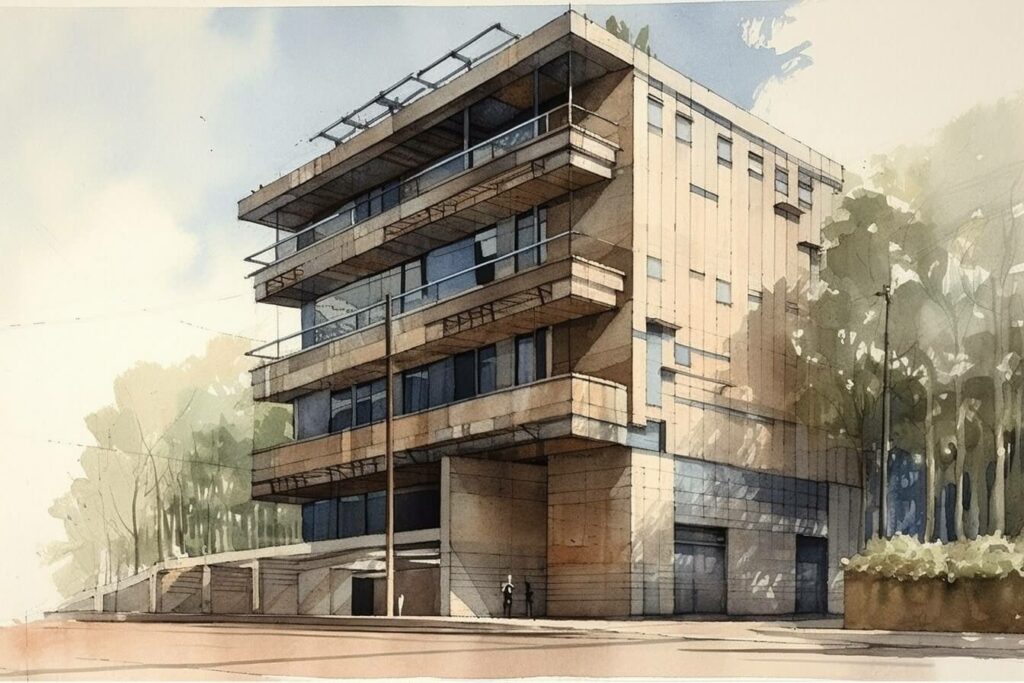



A 2-day immersion into the future of sustainable construction
Architects and interior designers continuously seek innovative solutions to enhance aesthetics, improve energy efficiency, and promote sustainability in their projects. Enter the ventilated facade, a cutting-edge building envelope technology rapidly gaining traction in architecture.
This comprehensive guide will delve into the numerous benefits, most asked questions, and the future of ventilated facades. So, buckle up and get ready to explore the fascinating world of ventilated facades.
What is a Ventilated Facade?
A ventilated facade, a double-skin facade, rain screen, or cladding system is a building envelope technology consisting of an outer layer and an inner layer separated by an air cavity.
This gap allows for continuous airflow, effectively reducing thermal transfer and moisture buildup, enhancing overall building performance, and providing various benefits.
Ventilated Facade Components
A ventilated facade system typically comprises three primary components:
- Outer cladding: This is the external skin made of materials like metal, glass, ceramics, or wood, which protects the building from weather elements and provides aesthetic appeal.
- Air cavity: The space between the outer cladding and the inner insulation layer, which facilitates air circulation, moisture management, and temperature regulation.
- Insulation layer: The innermost component that ensures thermal comfort and energy efficiency by reducing heat transfer between the building’s exterior and interior.


Why Choose Ventilated Facades?
Ventilated Facade Benefit #1: Energy Efficiency
One of the most significant advantages of ventilated facades is their ability to improve a building’s energy efficiency.
By creating a continuous air barrier and incorporating high-performance insulation, these systems can effectively reduce heat transfer, lowering energy consumption for heating and cooling purposes.
Ventilated Facade Benefit #2: Moisture Management
The air cavity in a ventilated facade system helps to eliminate moisture buildup, reducing the risk of mold and mildew growth. This feature not only enhances indoor air quality but also prolongs the lifespan of building materials by minimizing water damage and corrosion.
Ventilated Facade Benefit #3: Aesthetic Appeal
Ventilated facades offer various design possibilities, allowing architects and interior designers to create visually striking exteriors showcasing creativity. The options are endless, from sleek metal panels to warm wooden cladding.
Ventilated Facade Benefit #4: Acoustic Performance
By incorporating sound-absorbing materials in the facade system, ventilated facades can significantly reduce noise pollution, creating more comfortable and peaceful indoor environments.
Ventilated Facade Benefit #5: Sustainability
Implementing ventilated facades can contribute to the overall sustainability of a building by minimizing energy consumption, reducing greenhouse gas emissions, and promoting the use of recyclable and eco-friendly materials.
Section 3: Most Asked Questions About Ventilated Facades
How Much Does a Ventilated Facade Cost?
The cost of a ventilated facade system can vary significantly depending on the chosen materials, design complexity, and project scale. However, the long-term energy savings, reduced maintenance costs, and potential for increased property value often outweigh the initial investment.
Can Ventilated Facades Be Retrofitted?
Yes, ventilated facades can be retrofitted onto existing structures, offering a practical solution for enhancing energy efficiency, moisture management, and aesthetic appeal without requiring extensive renovations.
Are Ventilated Facades Suitable for All Climates?
Ventilated facades are highly versatile and adaptable to various climate conditions. By customizing the design and materials, these systems can effectively accommodate different climates’ unique thermal and moisture challenges, ensuring optimal performance and comfort.
How Do Ventilated Facades Impact Fire Safety?
Fire safety is a critical consideration when implementing a ventilated facade system. While the air cavity can potentially contribute to spreading flames, proper design and fire-resistant materials can significantly mitigate this risk. It is essential to consult with experts and adhere to local building codes and regulations to ensure fire safety.
How Do I Maintain a Ventilated Facade?
Ventilated facades require relatively low maintenance due to their self-ventilating nature and resistance to moisture damage. Periodic visual inspections and cleaning of the outer cladding can help maintain the system’s appearance and performance. However, the maintenance requirements will vary depending on the materials used and local environmental conditions.
Conclusion: The Future is Ventilated With Ventilated Facade
Ventilated facades are transforming the architectural and interior design landscape by offering many benefits, including improved energy efficiency, moisture management, aesthetic versatility, and enhanced sustainability. As more professionals embrace this innovative technology, the demand for expert guidance and ongoing education continues to grow.
Join the ranks of forward-thinking architects and interior designers by exploring UGREEN’s sustainability consultancy services or discovering UGREEN Skills, our sustainability educational platform for professionals and companies. Together, we can create a future that is not only beautiful but also sustainable and energy-efficient.






A 2-day immersion into the future of sustainable construction
If you need our services in the Portuguese language, click here.

